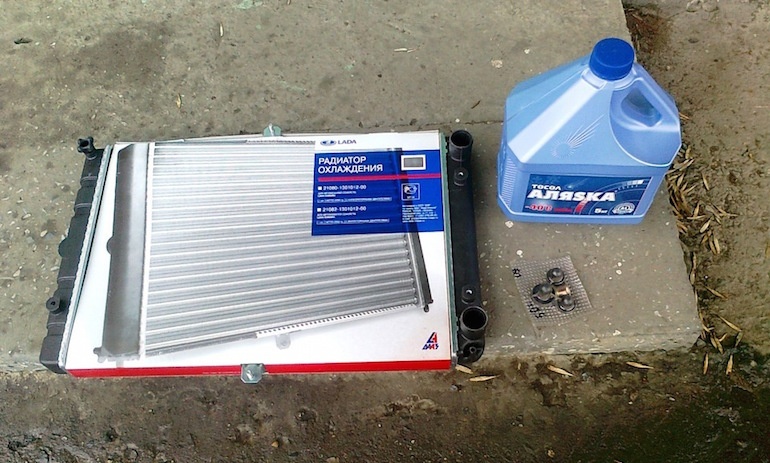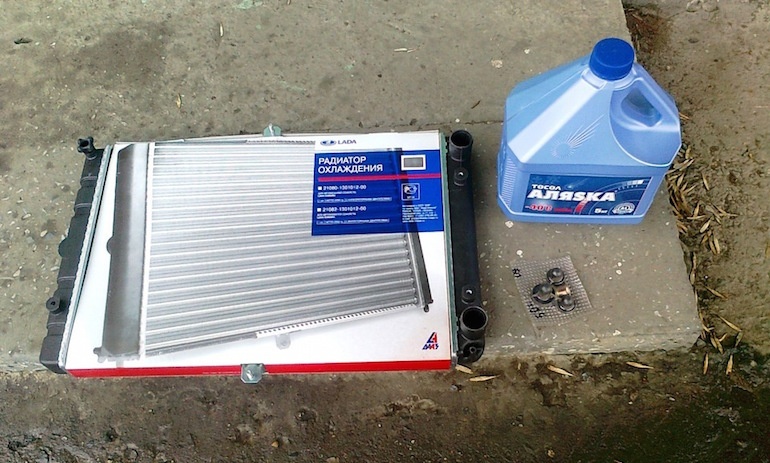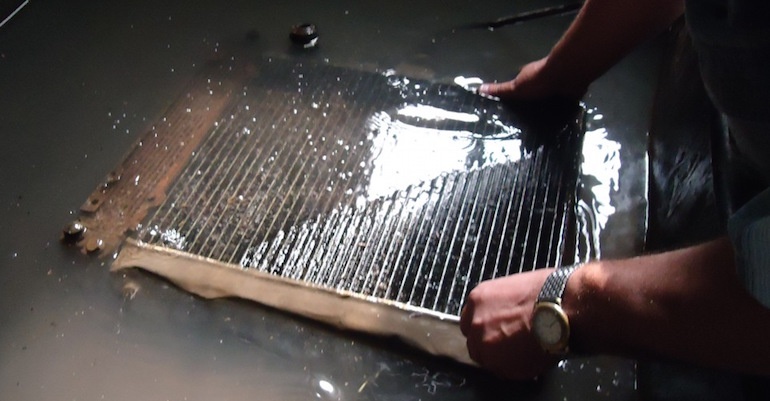
How to eliminate a leak in a car cooling radiator without removing it, folk remedies
As you know from the physics course, when the motor is running, heat is always generated. The engine of a car performs a huge amount of work and at the same time gets very hot. Even in the very first cars, an engine cooling system was used, without which no car could function normally.
There are several types of engine cooling systems:
- air;
- liquid;
- combined.
In the overwhelming majority of modern cars, it is the liquid system in which cooling is achieved by means of a coolant - antifreeze, antifreeze or plain water. The main element of the cooling system is the radiator, which acts as a heat exchanger.

The radiator has a fairly simple design:
- upper tank - heated liquid enters it;
- core - consists of many thin plates and vertical tubes;
- lower tank - already cooled liquid flows into it.
Cooling occurs due to the fact that the flow of liquid flows into tubes, of which there are a lot. And small volumes of any substance are much easier to cool than large volumes. An important role in cooling is played by the fan impeller, which rotates to create air currents for faster cooling.
It is clear that if the cooling system ceases to function normally, the engine will overheat very quickly and fail.
Over time, cracks can form in the radiator pipes. The reasons for their appearance can be very different:
- mechanical damage;
- corrosive processes - improperly selected antifreeze or antifreeze;
- cracked seams at the joints of the pipes - the seams crack due to old age, as well as due to an increase in pressure inside the radiator.
It is also important to pay attention to the fact that a small leak of antifreeze can be detected only when the engine is running. Even if the leak is very small - a few drops per minute - you will still notice that the liquid level in the reservoir is decreasing. We already wrote on our auto portal Vodi.su that a good antifreeze or antifreeze is quite expensive, and there is no desire to constantly add it to the radiator. Therefore, it is necessary to take measures to eliminate the increased consumption of antifreeze.

Remedies for Leakage
If you find that the level of antifreeze is decreasing, you need to take measures as soon as possible to get to the nearest workshop.
First of all, you need to establish the cause of the leak - the radiator itself is leaking or the liquid is leaking from the pipes. If the leak is small, then it is not so easy to detect it on the road. Without turning off the engine, try to visually identify the place where the liquid is dripping. If it's winter outside, steam will escape from the hole or crack.
If you are convinced that it is the radiator that is leaking, then you need to determine the size of the damage. You can prevent a small leak with the help of ordinary eggs, flour, pepper or mustard - under the influence of hot antifreeze, the eggs inside the radiator will boil and the pressure will nail them to the crack. Flour or pepper will also bunch up and plug the hole from the inside.
Be very careful before pouring or pouring all this into the radiator - you can unscrew the plug only when the engine is off and coldhigh pressure builds up inside the radiator and a jet of coolant can escape under the pressure and burn you. Unscrew the radiator cap, pour one or two eggs inside, or add a small 10 gram bag of pepper, flour or mustard.

According to the testimony of many motorists, such a simple method really helps. The leak disappears. However, then you will have to completely remove the radiator and rinse it, since the tubes can become clogged and will not allow antifreeze to pass through.
What to use to fix the leak temporarily?
Means are very popular Liqui Moly, namely a tool called LIQUI MOLY Cool poet - it is recommended to buy it by experts. There are many other similar products, but no one can guarantee that the same flour or mustard is not used in its composition. It is even worse when dry building glue or cement is added to such sealants. The use of such a tool will lead to clogging of the cells and subsequent overheating of the engine.
If we talk about Liqui Moly sealants, then they contain polymer additives in the form of sparkles that will not clog the radiator tubes, but will settle exactly at the place where the crack is formed. Although it should be noted that this is only a temporary measure, besides, the sealant will not plug quite large cracks.
Therefore, you will have to choose from several options:
- solder the radiator;
- glue with cold welding;
- acquire a new one.
Radiators are usually made from brass, copper or aluminum. Aluminum cannot be soldered, so cold welding is required - a special two-component epoxy-based adhesive.
To make this welding last longer, you need:
- let the motor cool down;
- find a crack and mark it;
- completely drain the liquid from the radiator;
- degrease the damaged area;
- apply glue and leave for 2 hours to adhere well.
If it is impossible to get to the leak, or if it is impossible to find the damaged tube at all, you will have to completely remove the radiator.

There are several ways to detect a crack:
- lower the radiator into the bath and bubbles will come out of the crack;
- connect the compressor and supply air - you will feel where the air is leaking from.
It must be said that cold welding under the influence of high temperatures and pressure can leak, so it must also be taken as a temporary measure.
Copper or brass radiators are soldered with a special soldering iron - its power is at least 250 watts. The soldering point must be completely descaled and degreased. Then the metal needs to be heated well, the rosin should be applied in an even layer, and then the solder itself should be applied. The solder should lie in an even layer without cavities and irregularities.
And finally, the most extreme way is to simply pinch or plug the leaking tube. The design of the radiator is such that up to 20% of the cells can be drowned out without worrying that this will lead to overheating of the engine.
Please also note that the radiator pipes, which are made of rubber, can leak. In principle, a set of pipes can be bought in almost any store, especially for domestic cars. You can also glue them with special rubber patches, raw rubber or vulcanization. For reliable contact of the nozzle with the radiator outlet, you can use additional metal clamps, which are also sold in any hardware store.
Well, if none of these methods helps, the only way out is to buy and install a new radiator.
Video showing the application of LIQUI MOLY Kuhler Dichter sealant.
In this video, the specialist tells what problems can arise when sealing a radiator, as well as what mistakes are most often made by motorists.
Loading…
